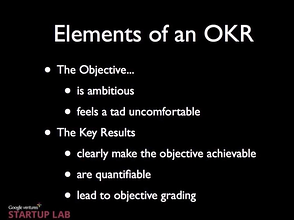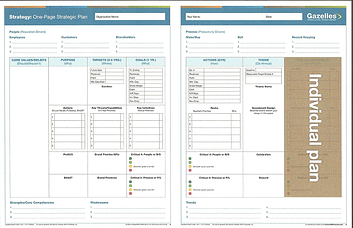You’re probably familiar with the term KPI’s or Key Performance Indicators. KPI’s are driven by top-down leadership decisions. These are the Key Performance Indicators for the company based on the Annual, Quarterly and Trimester planning and strategy meetings businesses have to set direction for the business.
In Exponential Organizations: Why new organizations are ten times better, faster, and cheaper than yours (and what to do about it) by Salim Ismail, Michael S Malone, Yuri van Geest it notes, “Even as the instrumenting of businesses accelerates, a similar transformation is also taking place at the level of individual employee and team performance tracking. The dreaded annual performance review is demotivating for most employees, and is especially so for high achievers because of the long delay between accomplishment and recognition. During that interval, top employees are at risk of becoming frustrated, bored, and moving on—costing fast-growth companies the employees they can least afford to lose.”
The book continues, “Many are now implementing high-frequency OKRs—that is, a target per week, month or quarter for each individual or team within a company.  Scientific results in neuroscience, gamification and behavioral economics have shown the importance of both specificity and frequent feedback in driving behavioral change and, ultimately, having an impact. Specificity and rapid feedback cycles energize, motivate, and drive company morale and culture.”
Scientific results in neuroscience, gamification and behavioral economics have shown the importance of both specificity and frequent feedback in driving behavioral change and, ultimately, having an impact. Specificity and rapid feedback cycles energize, motivate, and drive company morale and culture.”
If you’ve forgotten or don’t know the reason Precision & Specificity are critical to individual, team. and business success please read Priorities Discipline Requires Precision and Specificity. Better yet read the book Be Excellent at Anything by Tony Schwartz to discover examples of how precision and specificity help achieve objectives.
Here are some characteristics of OKR or Objectives and Key Results:
- KPI’s are determined top-down, OKR’s are determined bottom-up
- Objectives are the dream; Key Results are the success criteria a way to measure incremental progress towards the objective.
- Objectives are qualitative and Key Results are quantitative. OKRs are not the same as employee evaluations. OKRs are about the company’s goals and how each employee contributes to those goals. Performance evaluations, which are entirely about how an employee performed in a given period, are independent of OKRs.
- Objectives are ambitious and should feel uncomfortable. [In general, up to five objectives and four key results per initiative are optimal, and key results should see an achievement rate of 60-70%: if they don’t, the bar is set too low.]
How fast is your company growing? Is accountability an issue in your company?
OKRs are the equivalent of the Business Dashboards we require our Gazelles coached leadership teams to develop and review each weekly meeting.  In reality OKRs are the individual dashboard section on the One Page Strategic Plan. See Highlighted section on the left.
In reality OKRs are the individual dashboard section on the One Page Strategic Plan. See Highlighted section on the left.
Accountability is nothing more than keeping score. It’s Pearson’s Law, it’s Strategic Discipline, and it begins with setting expectations.
Ralph C. Stayer (Johnsonville Sausage Company) & James Belasco, write in the Flight of the Buffalo, “Do the people in your company know how well they’ve done before they go home every night? People perform what they measure – help the performers to measure the “right” stuff.”
Truly if they don’t it’s not hard to understand why you have accountability issues is it?
Similarly if you’re not measuring them and reporting back their results you’re failing to leverage the dynamic power of Pearson’s Law, “When performance is measure, performance improves, when performance is measured and reported back, performance improves dramatically.”
In a Gazelles/Rockefeller Habits company the intention is to develop the KPI’s for the organization based on the priorities identified in Annual Strategy and Planning meetings as well as subsequent Quarterly or Trimester meetings. When done correctly it aligns the company from top to bottom. The leadership team, specifically the CEO should launch the year and the quarter by introducing the priorities and One Thing to the entire team early January or late December. The teams beneath the leadership team establish their priorities to compliment the organizations priorities. Each individual in the company should correspondingly provide their OKRs to scale up from their positions to align with the company and team objectives. This is how alignment is coordinated.
Don’t make the mistake as the manager or leader of your team of setting their individual objectives. Responsibility and accountability is built through requiring each individual team member to complete their OKRs to reflect their expectations. They need to own their OKRs.
Fabio Troiani, managing director of Business Integration Partners, a global consultancy based in Italy, observes that OKRs are still unique even to Silicon Valley. He reports that of the hundred large corporations in Europe and South America with which he’s familiar, none use OKRs.
Don’t expect that the first attempt to achieve this everything will fall quickly into place. Many people are not familiar with setting goals and objectives and you may require patience and a learning curve to get everyone on board.
At the same time, if you have younger teams you may find they adapt quickly since embedded within the highly popular game of World of Warcraft are dashboards similar to OKRs and Lean metrics with short feedback cycles.
A critical element of building accountability with your team should be meeting rhythms. Weekly meetings with your team should provide peer pressure to perform. Here’s another critical element to consider:
Recently Google conducted a management survey. The data is clear and compelling. What do you think #1 key to be considered an effective, successful manager in employee’s minds? What might that key attribute or action might be?
The attribute and action that the most successful managers take is conducting regular one-on-one coaching with their direct reports. If you’re not already doing one on one meetings you may want to start. We’ll discuss this more in a future blog.
If you’re looking to make 2015 a better year than 2014, establishing OKR’s with your team is a good way to establish the right platform to achieve better results.
Have you noticed gas prices dropping your neighborhood? An important part of planning and strategizing is discussing trends. Gas prices in Iowa have dropped nearly $1.50 a gallon in the past 2-3 months. Is this a trend that will continue? Is it a trend that can affect your business? What are trends and why should you and your leadership and management team be discussing these at annual planning and strategy sessions? We’ll look at SWT: Strengths, Weaknesses and Trends next blog.






.jpeg?width=150&height=135&name=Hand%20with%20marker%20writing%20the%20question%20Whats%20Next_%20(1).jpeg)

